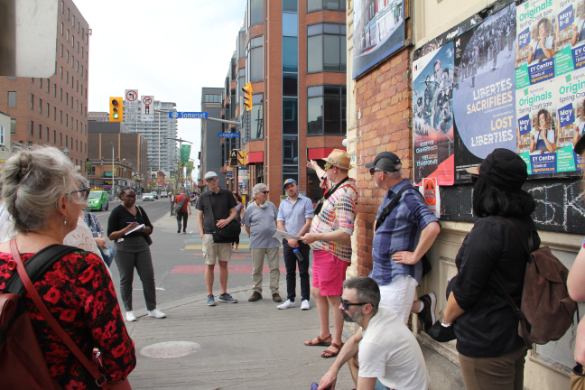Student Blog: Ordinary Places, Extraordinary Stories
We are continuing our series of student blogs with a number of reflections on the “Small Modernisms” symposium, a public event held at the Carleton Dominion-Chalmers Centre on May 12-13, 2022. The event was organized by Professors Michael Windover and Dustin Valen. The blogs were written by undergraduate students in the History and Theory of Architecture and Art History programs in Carleton’s School for Studies in Art and Culture.

By Purity Gituma
The postwar period in Canada is often described by scholars as an era of reconstruction, both in terms of rebuilding the nation after WWII, and of reconstructing modern Canadian identities. “Small Modernisms” re-evaluated this interpretation by portraying a more intimate, and less idealized representation of postwar Canadian society.
As a student, I found it refreshing to learn about topics that have not received attention in Canadian architectural discourse, including projects that allow for a broader and more inclusive discussion about this moment in Canadian history. Presenters at the symposium explored the development of a diverse range of uncommon typologies, including roadside fruit stands, community centres, and adventure playgrounds. Likewise, David Monteyne’s paper on the promotion of American-inspired fallout shelters in Canada drew attention to small-scale civil defence infrastructure designed with the average Canadian homeowner in mind. His discussion was revelatory because it conveyed the realities of the Cold War and highlighted the contrast between the conception of Canadian and American society in the 1960s. Shedding light on unconventional building types and other neglected aspects of this era expands the possibilities of what Canadian architectural history can encompass.
Other scholars offered unique insights about the history and legacy of postwar public building projects by focusing on marginalized groups and their experience of the postwar city. The lived experience of marginalized groups, such as Indigenous Peoples, immigrant families, women, and members of the LGBTQ+ community are seldom discussed in mainstream scholarship on Canada’s built environment. However, “Small Modernisms” demonstrated that architecture can accommodate a multiplicity of meanings and perspectives that are worth considering. Scholars such as Tanya Southcott, Olivier Vallerand, Cynthia Hammond, and Sara Stevens, touched on the injustices brought about by the demolition of entire neighbourhoods to make way for public infrastructure and housing projects in the 1960s and 1970s. During Hammond’s presentation on immigrant experience in postwar Montreal, for example, I heard first-hand testimony by residents about the heartbreaking impacts of redevelopment in Montreal’s Chinatown. I felt challenged and overcome with emotion. Learning about the harsh realities of forced relocation encouraged me to consider how architectural symbols of progress, optimism, and innovation were also a source of trauma, injustice, destruction, and loss for others.
As difficult as it may be, acknowledging the ills of some postwar projects can also lead to healing, and even help bring justice to impacted communities. This was well represented in Trina Cooper-Bolam’s discussion on Indigenous Peoples’ reclamation of the former Shingwauk Residential School, through a collaborative process involving survivors, digital media artists, and academic researchers. Considering the school’s tragic and complicated history, I was initially surprised to learn that residential school survivors agreed to conserve the former school building. But upon reflection, I believe this initiative to preserve Indigenous heritage for the sake of education and healing supports the process of reconciliation. It is encouraging to know that Indigenous Peoples are involved in negotiating these changes, interpreting former school sites, and creating forums to share their unique experiences.
First-hand experience of historic sites not only strengthens our understanding of these places but also reinforces the relationship between historical narratives and their social contexts. By interpreting architecture in an immersive way, form and space create dialogue across time and allow us to imagine how buildings touch personal lives. In that sense, “Small Modernisms” was also impactful for its exploration of the pedagogical potential of walking tours. For example, Glenn Crawford’s walking tour traced the history of the Ottawa LGBTQ+ community from the postwar period to present day. The journey from Château Laurier—one of several places where members of the gay community met during the 1960s—to Bank Street and Somerset Street West—now the heart of Ottawa’s gay village, animated by pride flags and rainbow crosswalks—helped me understand the community’s struggle to gain acceptance and visibility in Canadian society. Likewise, Brian McDougall’s walking tour highlighted the role of the National Capital Region in providing a platform for various social justice movements, including the abortion rights caravan that arrived on Parliament Hill in April 1970. As McDougall pointed out, the protest was notable because of how women lobbied for change by occupying key parts of Parliament Hill. Overall, the tours demonstrated that Canada has come a long way but there is still work to be done. Equality, discrimination, and other social issues remain major topics of conversation today, and architecture continues to play a role in influencing positive change.
Ultimately, “Small Modernisms” shows us that the connection between people and place is at the heart of architectural meaning. Ordinary spaces and places hold remarkable and rich histories that are arguably more representative of the ethos and composition of Canadian society during the postwar period. It is important we give a voice to these diverse actors and create platforms where their stories can be shared. Doing so allows us to rethink how we approach architectural history today, and what role it could play in inspiring more equitable futures.